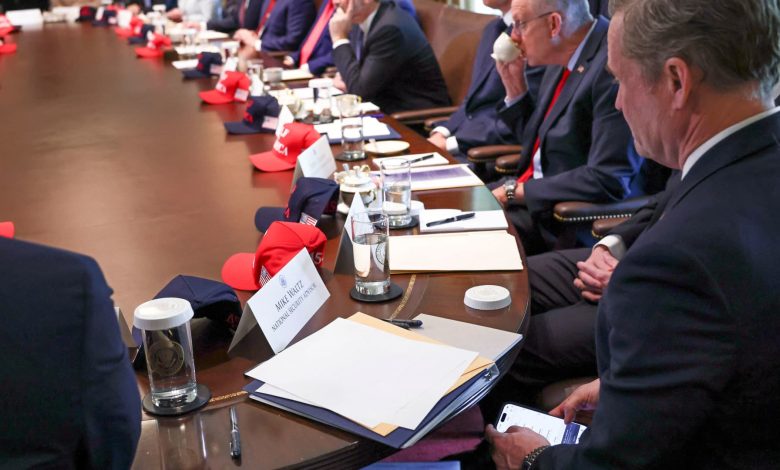Trump officials on Signal after president discourages it

U.S. National Security Advisor Mike Waltz checks his mobile phone while attending a cabinet meeting held by U.S. President Donald Trump at the White House in Washington, D.C., U.S., April 30, 2025.
Evelyn Hockstein | Reuters
Former White House national security advisor Mike Waltz appears to be communicating with other Trump officials on Signal, after President Donald Trump discouraged using the messaging app in the wake of the leak controversy dubbed “Signalgate.”
A photo taken by Reuters’ Evelyn Hockstein during a Cabinet meeting Wednesday shows Waltz holding his phone below the table, with the encrypted-texting app open and visible.
It also shows that Waltz has active conversations with at least six other users, including one identified as “JD Vance” — the vice president.
Other users’ names in the photo are partially obscured by Waltz’s hand, but appear to be Secretary of State Marco Rubio, director of national intelligence Tulsi Gabbard and Steve Witkoff, Trump’s special envoy to the Middle East and his de facto Russia-Ukraine negotiator.
Timestamps visible on the threads indicate they were active as recently as Tuesday or the morning of Wednesday, the day of the Cabinet meeting.
U.S. National Security Advisor Mike Waltz checks his mobile phone while attending a cabinet meeting held by U.S. President Donald Trump at the White House in Washington, D.C., U.S., April 30, 2025.
Evelyn Hockstein | Reuters
Asked for comment, White House spokeswoman Anna Kelly told CNBC, “As we have said many times, Signal is an approved app for government use and is loaded on government phones.”
Yet it was the use of Signal by top Trump administration officials — including Waltz — earlier this year to discuss pending military strikes that triggered one of the biggest controversies so far in Trump’s second term.
In mid-March, Waltz was part of a thread with Vance, Defense Secretary Pete Hegseth and others in which the group discussed forthcoming airstrikes on Houthi targets in Yemen.
Waltz inadvertently added Jeffrey Goldberg, the editor in chief of The Atlantic, to the thread.
Goldberg reported that the app was used to discuss the sensitive military information, sparking calls from Democrats for Waltz and Hegseth to resign.
Trump publicly defended Waltz, and his administration sought to justify their actions by claiming that none of the information discussed on the threat was classified.
The Atlantic responded by publishing the entire text thread, prompting retired and current military officers to question how that information could be considered unclassified.
The Pentagon’s internal watchdog has opened an investigation into Hegseth over his use of what it called a “commercial messaging application for official business.”
In an interview with The Altantic published two days before Wednesday’s Cabinet meeting, Trump was asked if he learned any policy lesson from the Signalgate scandal.
“I think we learned: Maybe don’t use Signal, okay?” Trump said.
“If you want to know the truth. I would frankly tell these people not to use Signal, although it’s been used by a lot of people,” he said in the interview, which was conducted last Thursday. “But, whatever it is, whoever has it, whoever owns it, I wouldn’t want to use it.”
Trump said he does not use Signal himself.
Reuters’ photo drew attention on social media on Thursday afternoon, shortly after Trump announced his plan to nominate Waltz to be the U.S. ambassador to the United Nations.
The announcement confirmed earlier reports that Waltz would soon be leaving his role as national security advisor, marking the first big staffing shake-up of Trump’s second term in office.
Rubio will serve as interim national security advisor until that post is filled, Trump said on Truth Social.
“I’m deeply honored to continue my service to President Trump and our great nation,” Waltz wrote on X later Thursday.



